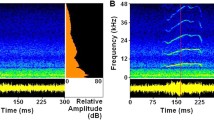Summary
The effect of acoustic stimuli on the testis volume and size of the interstitial cells and their nuclei was studied. Two different synthetic calls were used, both with the time pattern of the species-specific mating call: one at the natural frequencies, the other at 1,100 Hz (a major component of the territorial and release call). Exposure to 1,100 Hz resulted in diminished size of the interstitial cells and their nuclei, implying a reduction in androgen production. By contrast, presentation of the synthetic mating call maintained the function of the androgen system, so that the rate of production of androgen hormones and thus the sexual stimulation of the frog remained high. The role of the endocrine system in auditory communication among grass frogs in particular, and anurans in general, is discussed.
Similar content being viewed by others
References
Bogert, C. M.: The influence of sound on amphibians and reptiles. In: Animal sound and communication. Lanyon, W.E., Tavolga, W.N. (eds.), pp. 137–320. Washington D.C.: Am. Inst. Biol. Sci. 1960
Brockway, B.F.: Roles of budgerigar vocalization in the integration of breeding behaviour. In: Bird vocalizations. Hinde, R.A. (ed.), pp. 131–158. Cambridge: University Press 1969
Brzoska, J., Walkowiak, W., Schneider, H.: Acoustic communication in the grass frog (Rana t. temporaria L.): calls, auditory thresholds and behavioral responses. J. Comp. Physiol.118, 173–186 (1977)
Capranica, R.R.: Morphology and physiology of the auditory system. In: Frog neurobiology. Llinás, R., Precht, W. (eds.), pp. 551–575. Berlin, Heidelberg, New York: Springer 1976
Gelder, J.J. van, Evers, P.M.G., Maagnus, G.J.M.: Calling and associated behaviour of the common frog,Rana temporaria, during breeding activity. J. Anim. Ecol.47, 667–676 (1978)
Gerhardt, H.C.: Mating call recognition in the green treefrog (Hyla cinerea): the significance of some fine-temporal properties. J. Exp. Biol.74, 59–73 (1978)
Kemenade, J.A.M. van: The effects of metopirone and aldactone on the pars distalis of the pituitary, the interrenal tissue and the interstitial tissue of the testes in the common frogRana temporaria. Z. Zellforsch.96, 466–477 (1969)
Littlejohn, M.: Long-range acoustic communication in anurans: an integrated and evolutionary approach. In: The reproductive biology of amphibians. Taylor, D.H., Guttman, S.I. (eds.), pp. 263–294. New York: Plenum Press 1977
Lörcher, K.: Vergleichende bio-akustische Untersuchungen an der Rot- und Gelbbauchunke,Bombina bombina (L.) undBombina v. variegata (L.). Oecologia (Berlin)3, 84–124 (1969)
Narins, P.M., Capranica, R.R.: Communicative significance of the two-note call of the tree frogEleutherodactylus coqui. J. Comp. Physiol.127, 1–9 (1978)
Obert, H.-J.: Investigations into the significance of testicles and interrenal gland in the hormonal control of mating call activity in the common frogRana temporaria (L.). Zool. Jahrb. Physiol.79, 246–261 (1975)
Obert, H.-J.: Hormonal influence on calling and reproductive behavior in anurans. In: The reproductive biology of amphibians. Taylor, D.H., Guttman, S.I. (eds.), pp. 357–366. New York: Plenum Press 1977a
Obert, H.-J.: Etho-endokrinologische Untersuchungen zur Bedeutung der Paarungsrufe von Rotbauchunken,Bombina bombina (Amphibia, Anura). Verh. Dtsch. Zool. Ges.1977, 335 (1977b)
Schneider, H.: Acoustic behavior and physiology of vocalization in the European tree frog,Hyla arborea (L.). In: The reproductive biology of amphibians. Taylor, D.H., Guttman, S.I. (eds.), pp. 295–335. New York: Plenum Press 1977
Walkowiak, W.: The coding of auditory signals in the torus semicircularis of the fire-bellied toad and the grass frog: Responses to simple stimuli and conspecific calls. J. Comp. Physiol.138, 131–148 (1980)
Wells, K.D.: The social behaviour of anuran amphibians. Anim. Behav.25, 666–693 (1977)
Author information
Authors and Affiliations
Additional information
We thank Prof. Dr. H. Schneider for providing the equipment, Dr. W. Walkowiak for his help in synthetizing the calls.
Rights and permissions
About this article
Cite this article
Brzoska, J., Obert, H.J. Acoustic signals influencing the hormone production of the testes in the grass frog. J. Comp. Physiol. 140, 25–29 (1980). https://doi.org/10.1007/BF00613744
Accepted:
Issue Date:
DOI: https://doi.org/10.1007/BF00613744




